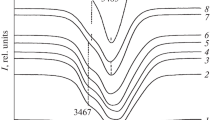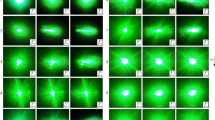Abstract
An investigation is performed of low-temperature changes in the electrical conductivity, optical absorption, and velocities of ultrasonic waves in congruent undoped and doped (Fe2+) crystals of lithium niobate during high-temperature annealing in vacuum. The effect electronic (polaron-type) processes in structural and impurity nanoscale complexes Nb5+–O2− and Fe2+–O2− had on their electrical, optical, and elastic characteristics is established. The possibility of changing such characteristics via targeted thermal annealing and optical irradiation is demonstrated.
Similar content being viewed by others
Avoid common mistakes on your manuscript.
INTRODUCTION
In [1, 2], we studied features of structural complexes of NbO6 formed by O2− ions around Jahn–Teller (JT) ions of Nb5+ and Fe2+ in congruent crystals of lithium niobate (LN) and the parameters of their local deformations. In this work, we present findings from a detailed study of changes in the optical, electronic, and elastic characteristics of LN crystals in a wide range of temperatures (500–77 K) and the possibility of deliberately changing them. Since ways of measuring the physical properties of LN were described in [3–5], we shall focus on our new results and their interpretation.
We studied series of 8 undoped and doped (with concentrations of Fe2+ ions ~5 ×1016 cm−3) LN samples annealed for 10 h in vacuum or oxygen at different temperatures. Studies of changes in their physical characteristics depending on the conditions of annealing began as early as the 1990s [4–7], but results were few and often contradictory [8, 9]. The main contradictions concerned processes and mechanisms of electrical conductivity and photo-induced changes in optical absorption and refraction, along with the participation of polarons in such processes. Special attention was therefore given to studying changes in the properties of LN samples in the poorly studied temperature range of 300–77 K.
The most important results were for abrupt changes in the electrical resistivity (ρ), energy of electronic activation (Ea), and optical absorption (α) of samples, depending on the temperature of annealing and the wavelength of optical irradiation.
It was found that the greatest changes in the electronic (Ea, ρ) and optical (α, n) parameters of all undoped LN samples were observed upon annealing in the range of 700 K < Tann < 1200 K with a maximum near Tann = 950 K (Fig. 1). In the 300 K ≤ Tmeas ≤ 500 K range of temperature measurements, the nature of temperature changes in the values of Ea, ρ, and α was the same and did not depend on the orientation of samples. When Tmeas < 300 K, however, the same parameters began to depend on orientation of the samples (Fig. 2). The electrical resistance underwent a record change in which the values of ρx and ρz could differ by five orders of magnitude for a sample with Tann = 920 K when Tmeas was reduced to 100 K. The greatest changes in α in the optical absorption spectrum were also observed in samples annealed at 870 K. Figure 3a shows the absorption spectrum at Tmeas = 77 K, where the bands with photon energy of 2.3 eV correspond to Fe2+ ions.
Temperature dependences of elastic modules Cij and deformations εi for a sample annealed in vacuum at 920 K. C11 and (C11−C12)/2 correspond to the distribution of longitudinal and transverse waves, respectively, along \(\bar {X},\) and C33 and C44 correspond to the propagation of longitudinal and transverse waves along \(\overline Z \). Curve 1 is a projection of the long Nb–O bond onto \(\bar {Z},\) and curve 2 is a projection of the short bond in lithium niobate.
The greatest changes in the optical spectrum were observed upon the optical irradiation of samples with Tann = 870 K using filtered beams with different wavelengths. There was simultaneous enhancement of the 3.4 and 1.6 eV bands, the latter of which corresponded to the transition Nb4+ → Nb5+ + \(\bar {e},\) and a change in band intensity at 2.3–3.2 eV that corresponded to ion recharge Fe2+ → Fe3+ + \(\bar {e}\) (Fig. 3b).
We assumed the undoped and doped LN samples had two temperature ranges for the mechanisms of electrical conductivity, induced optical absorption, and elastic characteristics, which are related to one process of the generation and absorption of several types of polarons, bipolarons and excitons that is controlled by electron–elastic (electron–lattice) interactions within the NbO6 octahedra containing JT ions of Nb5+ and Fe2+.
In the high-temperature range of 500–300 K, the electrical conductivity and change in optical absorption above 300 K were due to the movement of free thermally excited electrons between polarons \({\text{Nb}}_{{{\text{Li}}}}^{{{\text{4}} + }} - {\text{Nb}}_{{{\text{Nb}}}}^{{{\text{5}} + }}\) in adjacent octahedra of NbO6. In addition, the maximum in electrical conductivity was reached at Tann, which corresponds to the equality of concentrations of these ions (\({\text{Nb}}_{{{\text{Li}}}}^{{{\text{4}} + }} - {\text{Nb}}_{{{\text{Nb}}}}^{{{\text{5}} + }} + \bar {e}\)) in neighboring octahedra.
An analysis of our results indicated that the wide temperature range of higher conductivity in plane XY below 300 K was associated with the emergence of a low-temperature mechanism in which charge transfer proceeds through quantum tunneling transitions (hops) between localized electron states [9, 10]. Such hopping conductivity is created by the absorption and emission of optical single-frequency phonons [9], contributing to the energy of activation’s drop to 0.02 eV. It is obvious that such a low value of Ea prevented us from detecting ultra-small changes in electrical conductivity by direct means [7].
Such charge hops can in our case occur between electron-hole bound polarons (excitons) formed between closely spaced Nb5+ and O2− ions in a NbO6 octahedron under the conditions of strong electron–lattice interaction. Ions \({\text{Nb}}_{{{\text{Nb}}}}^{{{\text{5}} + }}\) and \({\text{O}}_{{{\text{Nb}}}}^{{2 - }}\) are contained in NbO6 octahedra in the form of polaron-type centers \({\text{N}}{{{\text{b}}}^{{{\text{4}} + }}} + \bar {e}\) and \({{{\text{O}}}^{ - }} + \bar {p}\) (holes). They form due to bonds with centers of the nearest environment of \({\text{Nb}}_{{{\text{Li}}}}^{{{\text{4}} + }}\) and \({{{\text{V}}}_{{{\text{Li}}}}}\) octahedra. Together, the polarons form bipolaron centers strongly related to induced (JT type) deformations of NbO6 octahedra and deformation of the crystal lattice as a whole, as was first predicted theoretically in [6] for undoped crystals. The formation of bound bipolarons \({\text{F}}{{{\text{e}}}^{{{\text{2}} - }}}{\text{--}}{{{\text{O}}}^{{{\text{2}} - }}}\) in octahedra is also possible in crystals containing Fe2+ ions, which can substitute for Nb5+ or Li2+ ions. The mechanisms of JT interaction caused by the formation of two types of bipolarons thus participate jointly in LiNbO3:Fe2+.
Theoretical calculations show that charge hops are most likely along planes X and Y, where there are coupled modes (stretching modes) of O–Nb [12] and the shortest distance between O2− and Nb5+ in octahedra. According to [11], it is this mode that is responsible for the generation of photoluminescence in a congruent LN sample in the temperature range of 225–20 K with a ~0.1 eV energy of activation. As indicated in [11], the greatest increase in photoluminescence occurs in a relatively narrow temperature range (~100 K) and depends on the concentration of excitons. The authors assumed that the frequency of exciton hops was an order of magnitude higher than the movement of ordinary polarons in the high-temperature region, according to the oscillatory model of Mott in [10], and was due to the emission and absorption of single-frequency optical phonons.
These conclusions are consistent with changes we observed in the elastic characteristics of ultrasonic waves below 300 K, and similar temperature changes in the intensity of photoluminescence [11], which is proportional to the concentration of excitons.
CONCLUSIONS
Large and abrupt changes in the values of elastic modules and acoustic attenuation in the temperature ranges of 350–200 and 150–170 K and electrical conductivity below 300 K were observed as a result of our experiments performed on the propagation of high-frequency ultrasonic waves and measurements of the electrical conductivity in a congruent undoped LN sample in the temperature range of 450–77 K. It was established that these anomalies were caused by local deformations of NbO6 octahedra of the JT type and NbO6 octahedra, along with their smooth variation throughout the temperature range of measurements below 300 K. Smooth changes in parameters ρ, Ea, and α fully agreed with the theoretical model of molecular crystal dynamics, while abrupt changes can be attributed to the effect polaron carrier transfer inside NbO6 octahedra has on the balance of elastic and electronic energies described by the JT effect.
REFERENCES
Golenishchev-Kutuzov, A.V., Golenishchev-Kutuzov, V.A., Kalimullin, R.I., and Semennikov, A.V., Bull. Russ. Acad. Sci.: Phys., 2017, vol. 81, no. 3, p. 282.
Golenishchev-Kutuzov, A.V., Golenishchev-Kutuzov, V.A., Semennikov, A.V., et al., Bull. Russ. Acad. Sci.: Phys., 2020, vol. 84, no. 12, p. 1494.
Golenishchev-Kutuzov, A.V., Golenishchev-Kutuzov, V.A., Kalimullin, R.I., and Semennikov, A.V., Bull. Russ. Acad. Sci.: Phys., 2018, vol. 82, no. 5, p. 558.
Akhmadullin, I.Sh., Golenishchev-Kutuzov, V.A., Migachev, S.A., and Mironov, S.P., Phys. Solid State, 1998, vol. 40, no. 7, p. 1190.
Akhmadullin, I.Sh., Golenishchev-Kutuzov, V.A., and Migachev, S.A., Phys. Solid State, 1998, vol. 40, no. 6, p. 1012.
Herth, P., Granzow, T., Schaniel, D., et al., Phys. Rev. Lett., 2005, vol. 95, no. 6, 067404.
Dhar, A., Singh, N., Singh, R.K., and Singh, R., J. Phys. Chem. Solids, 2013, vol. 74, no. 1, p. 146.
Shaldin, Yu.V., Gabriélyan, V.T., and Matyjasik, S., Crystallogr. Rep., 2008, vol. 53, no. 5, p. 847.
Mott, N.F. and Davis, E.A., Electronic Processes in Non-Crystalline Materials, Oxford: Clarendon, 1979.
Zvyagin, I.P., Kineticheskie yavleniya v neuporyadochennykh poluprovodnikakh (Kinetic Phenomena in Disordered Semiconductors), Moscow: Mosk. Gos. Univ., 1984.
Messerschmidt, S., Krampf, A., Freytag, F., et al., J. Phys.: Condens. Matter, 2019, vol. 31, no. 6, 065701.
Toyoura, K., Ohta, M., Nakamura, A., and Matsunaga, K., J. Appl. Phys., 2015, vol. 118, no. 6, 064103.
ACKNOWLEDGEMENTS
Some of our experiments were performed at the Kazan Institute of Physics and Technology, Kazan Scientific Center, Russian Academy of Sciences, for which the authors are grateful to S.A. Migachev.
Author information
Authors and Affiliations
Corresponding author
Ethics declarations
The authors declare that they have no conflicts of interest.
Additional information
Translated by S. Rostovtseva
About this article
Cite this article
Golenishchev-Kutuzov, V.A., Golenishchev-Kutuzov, A.V., Kalimullin, R.I. et al. Targeted Changes in the Optical, Electronic, and Elastic Characteristics of Undoped and Doped Crystals of Lithium Niobate. Bull. Russ. Acad. Sci. Phys. 85, 1333–1336 (2021). https://doi.org/10.3103/S1062873821120200
Received:
Revised:
Accepted:
Published:
Issue Date:
DOI: https://doi.org/10.3103/S1062873821120200







